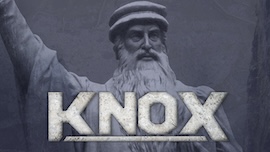Patrick Hamilton Was the First Star of the Scottish Reformation

ON THIS DAY, 9 June 1523, Patrick Hamilton became a member of Scotland’s oldest and most influential university: St Andrews. Four months later, he joined the arts faculty. What might have seemed like an innocuous career move was actually an event of considerable significance because at the same time that Hamilton was moving into a position of prominence, he was turning from Catholicism to Lutheran ideas.
Born near Glasgow, he began his training at the University of Paris at fourteen, which was not an unusual age to enter the university in those days. Following his studies in France, he went to Holland. He attended the University of Louvain briefly and probably studied under Erasmus before returning to his native Scotland. He was about nineteen when he entered St. Andrews.
At the time, Luther’s books and Tyndale’s New Testaments were pouring into Scotland. Hamilton was among those affected by them. By 1526, he was openly preaching Lutheran doctrine, even in the school’s cathedral. Archbishop of St. Andrews James Beaton, the highest-ranking Catholic churchman in Scotland, investigated. He ordered that Hamilton be formally summoned and accused. Considering how earlier cases had been handled, Hamilton knew this meant he would be burned at the stake. In April 1527, he fled to Germany.
Hamilton went to Wittenberg but the students had left because of plague. He remained long enough to hear Luther preach and to observe the changes that had come to the local church. Moving on to Marburg, he wrote a statement of belief, known as Patrick’s Places. Its first section contrasted law and Gospel in Lutheran terms: “The Law says, 'Where is your righteousness, goodness, and satisfaction?’ The Gospel says, ‘Christ is your righteousness, goodness, and satisfaction.’” Other sections also presented ideas heavily influenced by Luther.
Before the end of the year, Hamilton was back in Scotland. To show his break with the church of his youth, he married. He preached Lutheran doctrine boldly to his family and in surrounding regions. Archbishop Beaton summoned him to St. Andrews to discuss his teachings. Hamilton knew this would mean death, but he determined to go, believing that if he were martyred, people would take notice and the Lutheran message would spread.
Beaton allowed Hamilton a month of freedom, in which he disputed with champions of the established church. Then he arrested him. Because Hamilton’s family was powerful, Beaton gave him opportunities to escape. When Hamilton stayed to face the flames, he was burned alive on Leap Year Day in 1528. Wind and damp slowed the flame so that it took him six hours to die.
Appalled at this cruel execution, the Scots did inquire about Hamilton’s beliefs and read his pamphlet. As a result, many converted to Lutheranism. Although the Scottish Reformation became a Calvinist movement under John Knox, its origin was Lutheran, and Hamilton was the first of several Lutheran martyrs to die in Scotland.
—Dan Graves
----- ----- -----
John Knox benifited from Hamilton’s testimony and retold his story. Watch at RedeemTV.
Knox: The Life and Legacy of Scotland's Controversial Reformer can be purchased at Vision Video.







